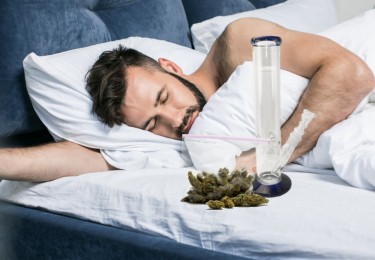Cannabis News
Oregon Cannabis: CIAO Wins Round One on Aspergillus Testing Rule!
Published
8 months agoon
By
admin
Oregon marijuana growers dreading the new aspergillus testing rule can exhale (for now). That’s because on Friday, August 25, the Oregon Supreme Court stayed enforcement of the new aspergillus testing rule pending a final hearing on the merits. This is a big deal! Kudos the Cannabis Industry Alliance of Oregon (CIAO) and the co-petitioners who filed a petition against the Oregon Health Authority (OHA) and Oregon Liquor & Cannabis Commission (OLCC) seeking judicial review of the new aspergillus testing rule. Kevin Jacoby, who represents the petitioners, did an excellent job. We’ve covered the aspergillus testing rule before here, here, and discussed the lawsuit here. We were not optimistic about the odds of success, but are quite pleased for our numerous clients who grow marijuana in Oregon.
Let’s dive into the ruling and what it means.
How did we get here?
In March 2023, the Oregon Health Authority (“OHA”) promulgated a new rule that required testing marijuana for certain microbiological contaminants, including for aspergillus. On July 28, 2023, the CIAO and others filed a lawsuit challenging the OHA’s new aspergillus testing rule. The petitioners seek to stop the OHA from enforcing the rule and when they filed suit they also filed a motion for emergency relief from the new aspergillus testing rule.
A litigant who seeks emergency relief compelling or preventing another litigant from doing something is fighting an uphill battle. Here, the petitioners had to establish to the Supreme Court that “irreparable injury probably would result” if a stay is denied. The Supreme Court also considers the likelihood that petitioners will prevail on the merits and the likelihood of harm to the public if a stay is granted.
Petitioners offered evidence that the harm to them from enforcement of the aspergillus testing would be “devastating and irreparable.” This evidence included petitioner’s showing that at least one of them would be out of business and causing a “risk of total business failure as soon as this fall” to numerous other marijuana growers if the stay was denied. Respondents (OHA & OLCC) argued the impact of the aspergillus testing rule was “highly exaggerated” but did not argue petitioners failed to show irreparable harm. The Court found petitioners made the required showing of irreparable harm.
The Court turned to whether petitioners demonstrated a likelihood of success on the merits, and ruled they did. Petitioners argued that the OHA exceeded its statutory authority in promulgating the aspergillus testing rule by failing to consider “less restrictive alternatives” as required by Oregon Statute 475C.544(8)(b). Petitioners directed the Court to evidence showing the OHA was aware of less restrictive alternatives adopted in other states and argued the aspergillus testing rule was more restrictive than necessary to protect public health. Respondents (the OHA), said the Court, did not raise a “clear response” to this argument. Because the legislature directed that the OHA standards “may not” be more restrictive than reasonably necessary, the Court ruled that petitioners have shown a likelihood of success on judicial review.
Finally, the Court examined whether staying enforcement of the aspergillus testing rule would negatively affect public health. Petitioners argued it would not. They pointed to Oregon’s eight-year track record of recreational marijuana and twenty-five year history of medical marijuana use. In all that time, explained petitioners, there has been no data linking cannabis consumption to higher rates of aspergillosis in Oregonians. The Court found this persuasive and made no mention of any evidence or argument presented by the OHA or OLCC.
What does the ruling mean?
Neither the OHA nor the can OLCC enforce the aspergillus testing rule at this time. Specifically, the court stayed enforcement, pending completion of judicial review, of the provisions of OAR 333-007-0390 relating to testing for “Aspergillus flavus, A fumigatus, A niger and A terreus.” The court did not stay the portions of the rule relating to “Shiga toxin producing Escherichia coli and Salmonella species,” which were not challenged in this case.
The Oregon aspergillus testing fight is not over
This is a big victory for cannabis growers in Oregon. But the case is not over. The case now proceeds to a full hearing where the parties may offer more evidence. Essentially, the Court decided to stay enforcement of the rule on an emergency basis, but the final decision comes later.
Aspergillus testing won’t be required this fall harvest
We highly doubt the case will progress in the next few months. That means, until further notice, the aspergillus testing rule cannot be enforced as described above.
Petitioners have the upper hand so far
This ruling is a boon for petitioners and Oregon marijuana growers. Reading between the lines of the opinion, the Court found petitioners presented very strong evidence and arguments that the OHA’s rule goes far beyond what may be needed to protect the public from aspergillus. Perhaps this will cause the OHA and OLCC to entertain discussions with the CIAO and others on how to rewrite the rule to protect both marijuana growers and satisfy the public health concerns that led them to adopt this rule.
Again, great work on behalf of the industry by the CIAO and others.
You may like
Cannabis News
Harnessing the Power of AI to Build Your Digital Cannabis Brand
Published
11 hours agoon
April 27, 2024By
admin

The world of technology is evolving at an unprecedented pace, and one of the most significant advancements in recent years is the rise of artificial intelligence (AI). Whether we like it or not, AI is here to stay, and it’s transforming industries across the board. As an entrepreneur, you have two options: fight against the tide or embrace the power of AI to propel your business forward.
In this article, we’re going to explore how you can leverage the rising trend of AI to empower your entrepreneurial journey in another thriving industry: cannabis. The cannabis market has been experiencing tremendous growth in recent years, with more and more states and countries legalizing the use of marijuana for medicinal and recreational purposes. This presents a unique opportunity for entrepreneurs to build a strong consumer brand or B2B service in the cannabis space.
While the principles and strategies we’ll discuss can be applied to any niche, we’ve chosen to focus on the cannabis industry to demonstrate how AI can be a game-changer for cannabis consumers looking to transition from being mere consumers to successful producers. By harnessing the power of AI, you can create a digital cannabis brand that stands out in a crowded market and connects with your target audience on a deeper level.
Throughout this article, we’ll walk you through the process of building a cannabis brand using AI in 2024. From developing your brand identity and creating compelling content to optimizing your website and leveraging data analytics, we’ll show you how AI can streamline and enhance every aspect of your brand-building journey.
So, whether you’re a cannabis enthusiast with an entrepreneurial spirit or an established business owner looking to expand into the cannabis market, this article is for you. Get ready to dive in and discover how AI can help you build a thriving digital cannabis brand in the ever-evolving world of technology and cannabis.
Let’s get started!
When it comes to building a successful digital cannabis brand, the first step is to come up with a solid concept. This is where AI can be incredibly valuable. By leveraging the power of Large Language Models (LLMs) like ChatGPT, Claude, and others, you can generate a wealth of ideas and insights to help you identify a profitable niche within the cannabis industry.
To get started, simply prompt the AI to generate a list of potential cannabis-related money-making ideas. Be sure to provide some parameters to ensure that the ideas are feasible and align with your skills, interests, and resources. For example, you might ask the AI to focus on ideas that can be executed with a specific budget, or that cater to a particular target audience.
Once you have a list of potential ideas, take some time to review and evaluate each one. Consider factors such as market demand, competition, and potential profitability. You can even use the AI to help you conduct market research and gather data on each idea to inform your decision-making process.
If you already have a product or service idea in mind, you can skip the ideation step and instead focus on using AI to develop strategies for growing your brand and acquiring customers. For example, you might ask the AI to generate ideas for content marketing, social media campaigns, or email marketing initiatives that are specifically tailored to the cannabis sector.
When using AI to come up with a concept, it’s important to remember that the outputs generated by the model are only as good as the inputs you provide. Be sure to ask clear, specific questions and provide enough context to ensure that the AI can generate relevant and valuable insights.
Ultimately, the key to success in the cannabis industry (or any industry, for that matter) is to identify a unique value proposition and deliver a high-quality product or service that meets the needs of your target audience. By leveraging the power of AI to help you come up with a winning concept, you’ll be well on your way to building a thriving digital cannabis brand in 2024 and beyond.
Now that you have a solid concept for your digital cannabis brand, it’s time to bring that concept to life by creating a strong brand identity. This is where you’ll define the visual and verbal elements that will represent your brand across all touchpoints, from your website and social media profiles to your product packaging and marketing materials.
One of the first steps in building your brand is to establish your online presence. While it may be tempting to jump on every social media platform out there, it’s important to be strategic and focus your efforts on the channels where your target audience is most active. Take some time to research your ideal customer and identify the platforms they use most frequently. Whether it’s Instagram, Twitter, or LinkedIn, choose one primary platform to focus on initially and master it before expanding to others. This will help you avoid spreading yourself too thin and ensure that you’re able to build a strong, engaged community around your brand.
In addition to your social media presence, it’s also recommended to create a self-hosted website and start building an email list. Your website will serve as the central hub for your brand, where customers can learn more about your products or services, make purchases, and connect with your brand on a deeper level. An email list will allow you to stay in touch with your customers and keep them informed about new products, promotions, and other brand updates.
When it comes to creating your visual brand identity, AI image generators like Leonardo.ai, MidJourney, ChatGPT plus, and Canva can be a great starting point. These tools can help you generate ideas for your logo, product packaging, and other visual elements. You can then refine and build out these ideas using photo editing tools like Photopea or Canva to create a cohesive and professional-looking brand identity.
Finally, use language models like ChatGPT to help you craft compelling brand messaging, including your bio, mission statement, vision, and product or service descriptions. While these tools can be incredibly helpful in generating ideas and content, be sure to edit and refine the outputs to ensure that they align with your brand voice and values.
By following these steps and leveraging the power of AI, you can create a strong, memorable brand identity that will help you stand out in the crowded cannabis market and connect with your target audience on a deeper level. Remember to link all of your brand elements together, from your website and social media profiles to your product packaging and marketing materials, to create a cohesive and seamless brand experience for your customers.
Content creation is the lifeblood of any successful digital brand, and this is especially true in the cannabis industry. Fortunately, with the advent of AI technology, creating high-quality, engaging content has never been easier. By leveraging the power of AI, you can save time and resources while still delivering valuable content that resonates with your target audience.
When it comes to written content such as blog posts, landing pages, website copy, and email copy, Large Language Models (LLMs) like Claude and ChatGPT are your best friends. These advanced AI models can generate human-like text based on your prompts and guidelines, allowing you to quickly and easily create compelling content that informs, educates, and engages your audience. As of the writing of this article, Claude is widely regarded as the most advanced and capable LLM, but others like Meta’s LLaMa are also making significant strides.
For visual content, AI-powered image generators like Leonardo and MidJourney are revolutionizing the way brands create graphics and imagery. These tools allow you to generate stunning, high-quality images with just a few prompts and guidelines, saving you countless hours of design work. Even Canva, a popular graphic design platform, now offers AI-powered image generation tools that make it easy to bulk create visual content for your brand.
One thing to keep in mind when using AI-generated visual content is the potential for generic or repetitive designs. While bulk creation can be a great way to save time and streamline your content creation process, it’s important to ensure that your visual content still feels unique and on-brand. This is especially true for content like quotes, tips, and tricks, where the message may be more important than the visual itself.
In addition to content creation, backend automation is another key area where AI can help streamline your business processes. Email marketing software like Zoho Campaigns and Mailchimp offer powerful automation capabilities that can help you nurture your leads and customers, deliver targeted messages, and keep your audience engaged with your brand. However, it’s important to note that some platforms like Mailchimp have strict policies against promoting cannabis-related products or services, so be sure to carefully review each platform’s guidelines before making a decision.
Finally, AI can also be used to create a wide range of marketing materials, including business cards, flyers, virtual flyers, and more. By leveraging AI-powered design tools and templates, you can quickly and easily create professional-looking marketing materials that help you stand out from the competition and attract new customers to your brand.
As we’ve explored throughout this article, the rise of AI technology has opened up a world of possibilities for entrepreneurs looking to build a successful cannabis brand. From concept generation and brand development to content creation and automation, AI is revolutionizing the way businesses operate and grow.
For aspiring cannabis entrepreneurs, there has never been a better time to take the leap and start building your own brand. With the power of AI at your fingertips, you can quickly and easily create high-quality content, develop a strong brand identity, and streamline your business processes – all at a fraction of the cost and effort required just a few years ago.
As AI technology continues to evolve and advance, the possibilities for cannabis entrepreneurs will only continue to grow. With open-source models like Meta’s LLaMa on the horizon, we’re quickly approaching a future where entire “offices” can be contained within a single machine, allowing entrepreneurs to run their businesses with unprecedented efficiency and flexibility.
But perhaps most importantly, the rise of AI is leveling the playing field for entrepreneurs of all backgrounds and experiences. No longer do you need a massive budget or a team of experts to build a successful brand – with the right tools and strategies, anyone can create a thriving cannabis business from the comfort of their own home.
So if you’ve been dreaming of starting your own cannabis brand, now is the time to take action. Embrace the power of AI, stay ahead of the curve, and seize the incredible opportunities that await you in this rapidly evolving industry.
The future of cannabis is bright, and with the help of AI, there’s no limit to what you can achieve. So what are you waiting for? Start building your brand today, and join the ranks of the successful cannabis entrepreneurs who are shaping the industry of tomorrow.
AI AND CANNABIS, READ ON…
Cannabis News
Cannabis as a Sleep Aid is Better Than Prescription Sleep Medications, Yes or No?
Published
12 hours agoon
April 27, 2024By
admin

Sleep is crucial for ensuring your mental and physical welfare. However, many grown-ups still experience difficulty sleeping.
According to the American Sleep Association, one-third to half of all adults in the USA (between 50 and 70 million) have difficulty sleeping. Statistics show that 40 million Americans have insomnia, and 10 to 15% of adults suffer from chronic insomnia.
If you find it increasingly challenging to catch some shut-eye, you are not alone. With so many people experiencing sleeping disorders, there’s been a rise in interest in one controversial cure: cannabis. Understanding the different administration routes, such as smoking, vaporizing, edibles, and topical applications, will help you make an informed decision regarding your choice of delivery method.
According to Dr. Matt Roman, a medical marijuana physician, cannabis is a natural sleep aid because it can help restore the normal sleep cycle, which revolves around the circadian rhythm, which wears out because of the modern-day pace of life.
If you struggle with a sleep disorder or find it hard to sleep after a tough day, cannabis could be an option. The pain-relieving effects of marijuana might help ease chronic pain. At the same time, its anti-anxiety properties can calm a stressed mind and body.
The Science of Cannabis-Induced Sleep
The compounds found in different strains of marijuana may vary. While some are more stimulating, others are soothing and sleep-inducing, based on the type and mixture of cannabinoids.
Let’s start with a brief overview of the science behind marijuana. This plant works its magic thanks to various cannabinoids, with two being particularly common:
Based on a 2008 studyTrusted Source, healthy users who smoke strains that contain higher THC levels usually don’t get as much REM sleep as compared to those who don’t. With the reduced amount of REM sleep, dreams are suppressed. In situations where one experiences PTSD, it means nightmares also decrease.
The idea is that when you cut down on dream time, you will have more time for a “deep sleep.” The deep sleep stage is usually considered the most rejuvenating part of the sleep mode, allowing deep revitalization and relaxation.
However, REM is also essential for the proper functioning of the cognition and immune system. Thus, prolonged use of marijuana with a THC concentration higher than 20% could impair your sleep quality.
However, this doesn’t apply universally. Certain studies indicate that frequent marijuana use could indeed disrupt sleep. It’s clear that cannabis alters sleep patterns but one uncertain thing is to what degree.
Be sure to consider those points that may affect you before you feel like trying cannabis.
Factors To Consider Before Trying Out Cannabis
-
Any smoking is a health risk that should not be taken lightly.
-
Talk to your doctor about your sleeping patterns. Interrupting REM frequently may have long-term health consequences, as many of the immune system’s repair actions take place during deep sleep.
-
Chronic use of any sleep aid agent is not advisable.
-
Please use marijuana responsibly. If you smoke, your chances of having COPD increase. Like cigarette smoking, smoking can increase the risk of COPD.
-
Marijuana smoking is harmful to the lungs, similar to cigarette smoking, and this is dangerous, especially to persons with asthma or other respiratory conditions.
-
Using marijuana while pregnant and breastfeeding isn’t advised.
How To Use Cannabis for A Good Night’s Rest
People usually smoke marijuana as joint or with a pipe. If you don’t like smoking, want to protect your lungs, or don’t fancy its specific smell, try vaporizers or high THC tinctures, which are placed under the tongue. Both methods are popular ways to consume cannabis for sleep.
Next is determining how much marijuana to use. It could require some small-scale trial-and-error to determine the precise dosage. So, don’t attempt this during office workdays! If you do smoke or vape, you will be better off savoring a few puffs at first.
Even a small amount can have a huge benefit. Don’t use too much, as oversleeping causes one to wake up feeling tired the next morning. If you need to take a second dose in the middle of the night, that’s okay. However, you should avoid re-dosing if you wake up less than four hours before you need to be up.
Pay attention to what effects you experience once you start smoking. One could feel entirely differently, ranging from a slight sense of happiness to an impression of time slowed to intensified feelings like dry mouth.
Timing Your Intake for Bedtime
The right time is just as important as the right Cannabis when it comes to having a good night’s sleep. The issue with edibles is that the timing of their effects can be unpredictable. Sometimes, it takes about an hour, while other times, it might take two to three hours.
Furthermore, its effects can last longer than expected and lead to morning grogginess. Due to the way cannabis is metabolized in our gut and liver, its duration of action can extend to 8 to 12 hours.
Since everyone’s body reacts differently, it’s generally recommended to consume marijuana at least an hour before bedtime. This timing is optimal because the effects of cannabis typically last for about three to four hours, assisting in falling asleep. This approach ensures that individuals don’t experience the effects just as they’re about to sleep, which could lead to heightened excitability and hinder sleep.
Conclusion
It’s important to recognize that not all sleep aids affect everyone in the same manner, and marijuana is no exception. Roman cautions that individuals with recent heart attacks or poor cardiovascular health should avoid cannabis use due to the heightened risk of myocardial infarction.
Additionally, although cannabis is frequently utilized to alleviate anxiety, some individuals discover that strains with high THC content increase their feelings of anxiety or paranoia.
If you’re among those who experience heightened anxiety from certain strains, consider experimenting with different varieties or informing your dispensary about your preferences when selecting strains. You may find that an alternative strain can promote sleep without exacerbating your anxiety.
USING WEED TO SLEEP, READ ON…
Cannabis News
Arizona Cannabis Sales Go Beyond $1.4 Billion
Published
1 day agoon
April 26, 2024By
admin
Arizona’s record-breaking cannabis market
In the landscape of booming and busting cannabis markets, Arizona emerges as a standout success story. A naturally beautiful state that attracts a sizeable group of tourists every year, Arizona skyrocketed past $1 billion in total cannabis sales for 2023. Unlike its northern neighbor of Nevada, Arizona has exceeded $1 billion in sales for three consecutive years, with 4.9% increase from ‘22 to ‘23 to boot. (Nevada, conversely, suffered from a nearly $115 million shortfall from FY 2022 to 2023 despite several millions more tourists than Arizona.)
Cannabis taxation and market comparisons
Compared to other states with recreationally legal cannabis, Arizona packs a considerably lower tax rate, levied as a 16% excise levy. Compare:
- Nevada levies a 25% tax rate, combining both wholesale and retail excise taxes
- Washington has an absurdly high 37% retail excise tax rate
- Montana taxes recreational cannabis sales at 20%
As of FY 2022, the per capita rate for excise taxes is also incredibly lower in Arizona than other recreationally legal states, at only $18. The only two states as of FY 2022 that had a lower per capita rate were both Maine and Michigan. Ironically, the two states with the highest per capita rate are also the first two states to legalize cannabis recreationally, Colorado and Washington, which have rates of $61 and $67 respectively.
Shift towards recreational cannabis sales
Recreational sales have become the life blood of the Arizona cannabis industry. Medical cannabis sales and the number of registered patients in the process are in decline. Whereas recreational sales accounted for only 45% of sales during the first year of retail sales in 2021, adult-use sales then increased to 70% in 2022. In 2023, recreational cannabis sales reached 72%, almost 30% larger than two years prior. Every month since July of 2022, the Arizona cannabis industry has exceeded $80 million in total retail sales.
Impact of regulatory environment on market performance
Like Nevada, Arizona cannabis retail stores benefit from rules that allow cannabis sales after midnight, and allow dispensaries to operate 24/7. Interestingly, unlike e.g. Montana or Minnesota, Arizona doesn’t benefit from any geographic advantage and is mostly surrounded by states with recreationally legal cannabis. This means that out-of-state visitors and business that Arizona receives from Utah certainly wouldn’t be as much as what Nevada draws in its two biggest cities. Yet, the Arizona cannabis industry is outperforming their northern neighbor, despite not possessing all the glitz and glamor of Las Vegas.
While cannabis professionals in the not so prosperous states of California and Oregon are watching some of the biggest juggernauts of business fully exit from their respective states, the billion-dollar Arizona market is seeing no such industry exodus. In particular, Curaleaf has become the best known example of a multi-state operator exiting a state completely, announcing their departure of “the majority of its operations” in California, Oregon and Colorado in 2023 and other East Coast states as well. Yet, that same MSO company has found thriving success in the Arizona market.
“Arizona has been a strong success story for us, and has become one of the top markets in the country for Curaleaf.” explained Curaleaf Vice President of Real Estate Luke Flood. “Uniquely, Arizona offers one of the lowest prices per gram at the retail level in the country.”
Allocation of Arizona cannabis tax revenue
Unlike other states which keep cannabis tax revenue allocations vague, Arizona specifically provides which causes and projects will benefit from the $172.8 million in 2023 excise tax revenue, and at what percentages.
- 33% will be allocated to community college and provisional community college districts.
- 25% will be sent to the Arizona Highway User Revenue Fund.
- 10% will go to the justice reinvestment fund, a program focused on providing health services and other social services, as well as job training for those unfairly impacted by previous cannabis prohibition.
- 10% will go to the justice reinvestment fund, a program which focuses on providing health services and other social services as well as job training for those unfairly impacted by previous cannabis prohibition.
- 10% will go to the justice reinvestment fund, a program which focuses on providing health services and other social services as well as job training for those unfairly impacted by previous cannabis prohibition.
- 3% will go to public safety, which means all branches of first responders.
Arizona’s cannabis industry outlook
Arizona’s cannabis industry stands as a beacon of success, breaking records and showcasing sustainable growth. The politically diverse state’s ability to surpass the $1 billion mark in sales for three consecutive years, despite having less tourists than adjacent Nevada, demonstrates the industry’s robustness. The state’s comparatively lower tax rates have also contributed to its success, making it an attractive market for both consumers and businesses. Finally, Arizona’s strategic location and regulatory environment have allowed it to thrive, even without the glitz and glamor of Las Vegas.
As the Arizona cannabis industry continues to evolve and expand, it will be fascinating to observe its future trajectory and impact on the broader cannabis landscape. Stay tuned.

Harnessing the Power of AI to Build Your Digital Cannabis Brand

Cannabis as a Sleep Aid is Better Than Prescription Sleep Medications, Yes or No?

Is Marijuana At Passover Kosher

Will Marijuana Help You Look Good In a Swimsuit

Bell’s Palsy And Marijuana

Arizona Cannabis Sales Go Beyond $1.4 Billion

Nicotine Salts Versus Freebase Nicotine: A Comprehensive Comparison

German cannabis imports rise to 34.6 tons as cultivators eye end of quota system

How To Vape Correctly – The Fresh Toast

Will Rescheduling Come In Time To Help The Marijuana Industry

Distressed Cannabis Business Takeaways – Canna Law Blog™

United States: Alex Malyshev And Melinda Fellner Discuss The Intersection Of Tax And Cannabis In New Video Series – Part VI: Licensing (Video)

Drug Testing for Marijuana – The Joint Blog

What you Need to Know

Cannabis, alcohol firm SNDL loses CA$372.4 million in 2022

NCIA Write About Their Equity Scholarship Program

City Of Oakland Issues RFP For Employee Training Programs

It has been a wild news week – here’s how CBD and weed can help you relax

A new April 20 cannabis contest includes a $40,000 purse

UArizona launches online cannabis compliance online course
Trending
-

 Cannabis News1 year ago
Cannabis News1 year agoDistressed Cannabis Business Takeaways – Canna Law Blog™
-

 One-Hit Wonders1 year ago
One-Hit Wonders1 year agoUnited States: Alex Malyshev And Melinda Fellner Discuss The Intersection Of Tax And Cannabis In New Video Series – Part VI: Licensing (Video)
-

 drug testing4 months ago
drug testing4 months agoDrug Testing for Marijuana – The Joint Blog
-

 Cannabis 1011 year ago
Cannabis 1011 year agoWhat you Need to Know
-

 Marijuana Business Daily1 year ago
Marijuana Business Daily1 year agoCannabis, alcohol firm SNDL loses CA$372.4 million in 2022
-

 Education1 year ago
Education1 year agoNCIA Write About Their Equity Scholarship Program
-

 Education1 year ago
Education1 year agoCity Of Oakland Issues RFP For Employee Training Programs
-

 Cannabis1 year ago
Cannabis1 year agoIt has been a wild news week – here’s how CBD and weed can help you relax











